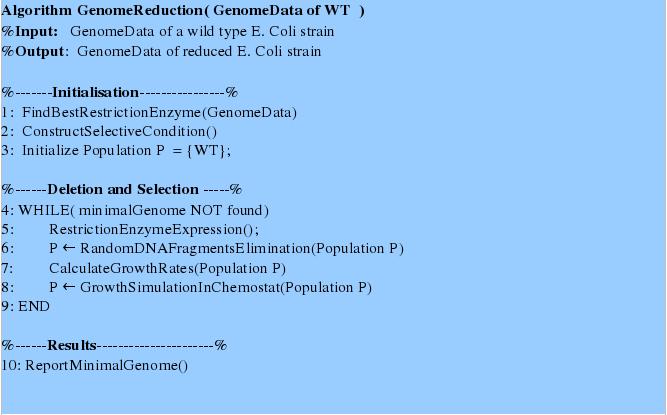Team:ETH Zurich/Project/Medal Relevant
From 2008.igem.org
m (New page: <html> <center> <embed src="https://static.igem.org/mediawiki/2008/3/3d/Ethmenu.swf" type="application/x-shockwave-flash" pluginspage="http://www.macromedia.com/go/getflashplayer" width="950" he...) |
m (→Modeling Framework) |
||
| Line 21: | Line 21: | ||
==== Modeling Framework ==== | ==== Modeling Framework ==== | ||
This algorithm requires a modeling framework consisting of four main parts: | This algorithm requires a modeling framework consisting of four main parts: | ||
| - | # [[Team:ETH_Zurich/Modeling | + | # [[Team:ETH_Zurich/Modeling/Genome_Static_Analysis|Statistical Analysis]] of DNA fragments produced by Restriction Enzymes |
# [[Team:ETH_Zurich/Modeling/Genome-Scale_Model| Flux Balance Analysis]] on a Genome Scale Model | # [[Team:ETH_Zurich/Modeling/Genome-Scale_Model| Flux Balance Analysis]] on a Genome Scale Model | ||
# [[Team:ETH_Zurich/Modeling/Chemostat_Selection|Growth Simulations in Chemostat]] | # [[Team:ETH_Zurich/Modeling/Chemostat_Selection|Growth Simulations in Chemostat]] | ||
Revision as of 17:48, 27 October 2008
Medal Relevant IssuesSilver RelevantGold RelevantWe propose a novel method of random gene deletion and chemostat-based selection of species with a reduced genome. For this we provide an algorithm described below. Modeling FrameworkThis algorithm requires a modeling framework consisting of four main parts:
Detailed description of the Modeling Framework
Summary of the Algorithm and Interplay of Frameworks ComponetsFirst tree steps initialize and prepare the system for gene deletions and growth simulations. In the first step the genome data are analyzed in order to find a most suitable restriction enzyme for random fragments deletion using the “Restriction Enzyme Analysis”- procedure. For the second step the state-of-the art model is adjusted by introducing a selective pressure due to the genome size. Thirdly, initial population consists of one type, namely wildtype. The next steps of the algorithm perform in depth genome fragments deletion and growth simulation. First, we simulate the restriction enzyme expression and the consecutive population decline and occurrence of new mutants with reduced genome, which growth rates can be predicted using Flux Balance Analysis. For these simulations we used the framework parts: “Switch generator” and “Flux Balance Analysis on a Genome Scale Model “. Secondly, the growth simulations are performed using a chemostat model and the distribution of different mutant types after the growth type are obtained. This simulation continues until no better mutants can be generated. Eventually, the genome data of the fastest growing reduced genome mutant can be returned.
|
 "
"
